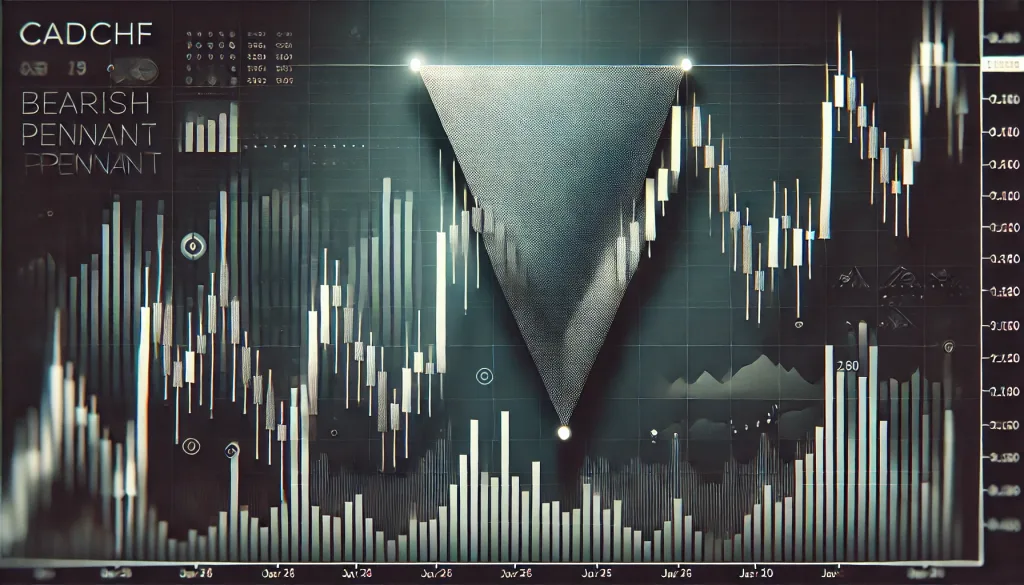CADCHF Bearish Pennant: The Hidden Pattern That Signals Big Moves

Introduction: The Trap Most Traders Miss Picture this: You spot a trade setup that looks as promising as a Black Friday deal on high-end sneakers. You jump in, confident that the market will reward your keen eye. But just as you start counting your imaginary profits, the trade reverses—hard. If this sounds familiar, you might have fallen for a classic trap: the bearish pennant on the CADCHF pair.
Most traders either misinterpret this pattern or, worse, ignore it altogether. But today, we’re going deep—real deep—into why the CADCHF bearish pennant is a goldmine for traders who know how to play it right.
What Is a Bearish Pennant? (And Why Should You Care?) Think of a bearish pennant like an exhausted sprinter who takes a short break before collapsing. It forms after a sharp drop (a flagpole), followed by a small consolidation that looks like a tiny symmetrical triangle. The market takes a quick breather, gathering just enough energy to continue its downward momentum.
Key Features of a Bearish Pennant:
- Sharp Decline (Flagpole) – A strong move downward sets the stage.
- Brief Consolidation (Pennant) – A small, symmetrical triangle or sideways movement.
- Breakout Downward – The real move happens when price action breaks below the pennant’s lower boundary.
So, how does this apply to CADCHF? Let’s take a behind-the-scenes look.
Why CADCHF Is the Perfect Playground for the Bearish Pennant If there were an Olympic event for sneaky price patterns, CADCHF would be a gold medal contender. Here’s why:
- High Correlation to Oil Prices – Since CAD (the Canadian Dollar) is highly correlated with oil prices, any drop in crude oil can push CADCHF lower, fueling bearish patterns like the pennant.
- Safe-Haven Strength of CHF – The Swiss Franc tends to strengthen during market uncertainty, which adds extra pressure on CADCHF, making bearish breakouts more forceful.
- Low Liquidity Traps – CADCHF isn’t the most traded pair, meaning stop hunts and aggressive breakouts happen more often, catching traders off guard.
Now, let’s get to the juicy part—how to actually trade it like a pro.
How to Trade the CADCHF Bearish Pennant Like an Insider This isn’t just another textbook setup. If you want to trade CADCHF bearish pennants profitably, you need next-level tactics:
1. Spot It Before the Crowd
Most traders only recognize the pattern after it’s too late. Instead, get ahead of them by identifying these signs:
- Volume Decline – The consolidation phase should have low volume, signaling hesitation before the breakdown.
- Lower Highs Formation – A sign that buyers are losing ground.
- MACD & RSI Confirmation – Look for RSI divergence or MACD bearish crossovers.
2. Enter with Precision
- Entry Point: Short the break below the pennant’s lower boundary.
- Stop-Loss Placement: Just above the highest point of the pennant.
- Take-Profit Target: Measure the flagpole’s length and project it downward from the breakout point.
3. Avoid the Fakeout (Where Most Traders Go Wrong)
- Fake Breakout Warning: If the breakout candle has a long lower wick, it’s likely a fake move.
- Wait for Retest Confirmation: Instead of rushing in, wait for price action to retest the broken level.
Real-World Example: CADCHF in Action Let’s take a look at a recent CADCHF bearish pennant setup that sent traders on a rollercoaster ride.
???? Case Study: December 2024 CADCHF Drop
- Initial Flagpole: 150-pip drop following weak Canadian employment data.
- Pennant Formation: A two-day sideways range with decreasing volume.
- Bearish Breakdown: CHF strength and oil price decline fueled a massive 200-pip move post-breakout.
Elite Traders’ Hidden Tricks for CADCHF Pennants If you want to play the bearish pennant game at a professional level, here are some ninja tactics:
✅ Use ATR (Average True Range) – Set dynamic stop-losses to avoid premature stop-outs.
✅ Track Oil Prices – A sharp decline in oil increases the probability of a successful bearish breakout.
✅ Watch CHF Strength – Strong CHF means CADCHF will likely break downward faster.
✅ Set Alerts on Trendline Breaks – Don’t babysit charts—use alerts to catch breakouts.
Final Thoughts: Your Next Move The CADCHF bearish pennant isn’t just a pattern—it’s a roadmap to precision trading. But only if you know how to handle it.
???? Pro Tip: Want access to real-time alerts, expert insights, and proprietary trading tools? Get an edge with our StarseedFX Smart Trading Tool—your shortcut to mastering CADCHF breakouts. Sign up here.
—————–
Image Credits: Cover image at the top is AI-generated
PLEASE NOTE: This is not trading advice. It is educational content. Markets are influenced by numerous factors, and their reactions can vary each time.

Anne Durrell & Mo
About the Author
Anne Durrell (aka Anne Abouzeid), a former teacher, has a unique talent for transforming complex Forex concepts into something easy, accessible, and even fun. With a blend of humor and in-depth market insight, Anne makes learning about Forex both enlightening and entertaining. She began her trading journey alongside her husband, Mohamed Abouzeid, and they have now been trading full-time for over 12 years.
Anne loves writing and sharing her expertise. For those new to trading, she provides a variety of free forex courses on StarseedFX. If you enjoy the content and want to support her work, consider joining The StarseedFX Community, where you will get daily market insights and trading alerts.
Share This Articles
Recent Articles
The GBP/NZD Magic Trick: How Genetic Algorithms Can Transform Your Forex Strategy
The British Pound-New Zealand Dollar: Genetic Algorithms and the Hidden Forces Shaping Currency Pairs
Chande Momentum Oscillator Hack for AUD/JPY
The Forgotten Momentum Trick That’s Quietly Dominating AUD/JPY Why Most Traders Miss the Signal
Bearish Market Hack HFT Firms Hope You’ll Never Learn
The One Bearish Market Hack High Frequency Traders Don't Want You to Know The

